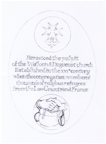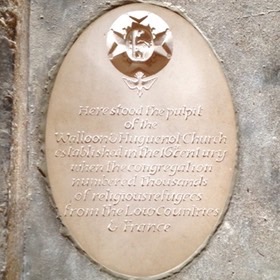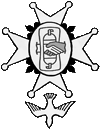
Conducting groups of visitors around the western crypt, it is striking how little there is to show that our congregation occupied that entire area for about 250 years. In the reveal of a south-aisle window, is a small solitary plaque commemorating Pasteur Joseph Auguste Martin (who, after re-invigorating the church, died in 1889) Long before his time, cartouches could be seen on the pillars flanking every arch, quoting extracts from the Bible - in French, of course. These were covered with whitewash after the congregation withdrew to the south aisle and now only feint remnants are visible. The easiest to identify is in the north colonnade, on the west face of the 3rd arch, counting from the west end:
Matthew, chapter XXVI, verses 40 - 41 Christ's words in Gethsemane
"Est-il possible que vous n'ayez pu veiller une heure avec moi ?
Veillez et priez, que vous n'entriez point en tentation;
car l'esprit est prompt, mais la chair est faible”
Since, traditionally, our services have always focussed on “The Word” delivered from the pulpit, I thought it would be appropriate to mark the place where our ancient pulpit used to stand. Working from old postcards, I was able to locate the exact spot by identifying the distinctive capitals and shafts on the pillars beside it. This was confirmed by feint diagonal markings on the floor, delineating the outline of a vanished base – larger than the one in the pictures. A blotch of cement in the floor seems to suggest that a gas pipe once provided lighting for the preacher's notes.
At a meeting of the French Church
Trustees, I submitted the proposition (with my
draft design for a plaque). From the outset, the Dean (an ex-officio trustee) gave his strong support, with a recommendation to the Receiver General. The Dean and Chapter gave their approval and sought endorsement from the Cathedral Advisory Committee.Final authorisation came from the national body which governs these matters: the Cathedrals Fabric Commission.
Discussions then began with Heather Newton, the Cathedral's Head of Stone Masonry and Conservation.
I had suggested that the Walloon badge – the beggar's bag – should be at the top, because our church was founded by Walloons. Our Pasteur Emeritus, Dr Hugh Boudin, ever-ready with his support and help, provided several specimens of that ancient badge for Heather to examine.
Heather's first design swapped the layout, putting the Huguenot cross at thehead; this was approved by the Consistory of our congregation butpreference was expressed for the Walloon badge to be a little more stylised. Consideration was given to various stones including Caen, Purbeck marble,and black marble from Tournai (in the Walloon heartland). Eventually the the choice settled on Portland limestone – the material used for the floor of the nave. Heather had wanted the inset panels to be in bronze, but this proved to be too costly and, at this point, the Dean generously suggested that the Chapter should fund the project.

Heather put forward a rather simpler design, using just one badge: our church's own, which dates from 1991 - the outset of Dr Boudin's decade as our pasteur. Being of Walloon stock, he had proposed that the founders of our church should be given due status by displaying their badge in our chapel and on our publications, alongside the cross adopted by the second wave of refugees – the Huguenots from France. As Secretary of the church at the time, and of Walloon descent myself, I warmly supported this idea, and then suggested that the two badges could be combined, creating a brand new symbol, signifying our church's dual origin.
After long debate, the design of the plaque was now settled.
Heather sketched the agreed design directly onto the stone plaque and thereafter most of the stone-cutting was executed by stonemason Ian Gartside. In December 2014, the finished plaque was placed in situ by Stonemasons’ Yard Supervisor Emlyn Harris and his colleague Benn Swinfield – beside the original location, rather than on the spot, so that the fine carving would not be hidden by chairs or trodden on. The work was undertaken late in the evening, as the vibration caused by drilling to remove a section of concrete floor to make room for the plaque was considered too intrusive to be done during the day time. The plaque has been placed on lime mortar directly onto the earth; as a result there will be a temporary discolouration of its surface which will gradually disappear over time.

The finished article speaks for itself.
Our congregation's pride in its ancient foundations and its long existence, in which our devoted pasteurs and successive administrations of the cathedral have played their part, is now attested in this plaque, which, thanks to the skilled artistry of Heather Newton and her team is, in itself, a lasting thing of beauty.
Michael H Peters 2015
